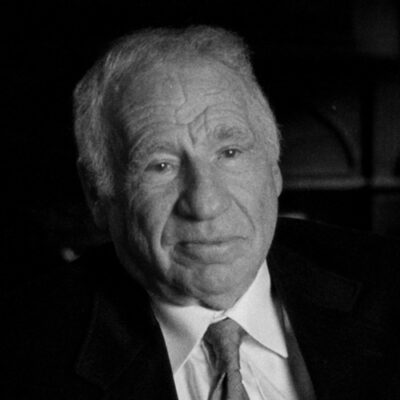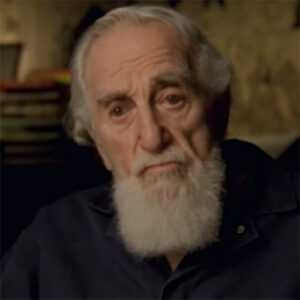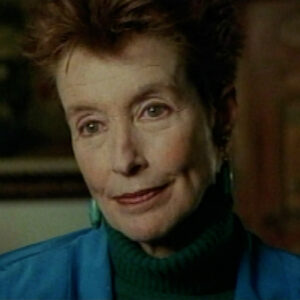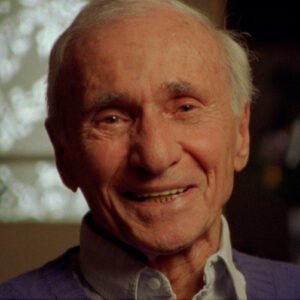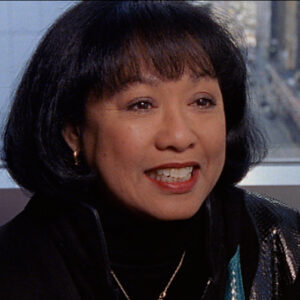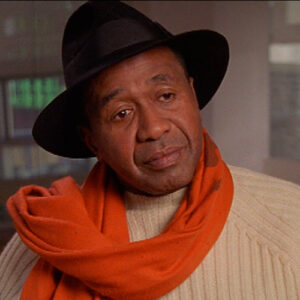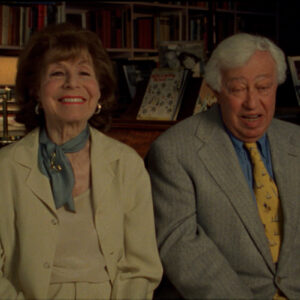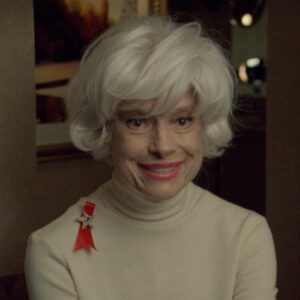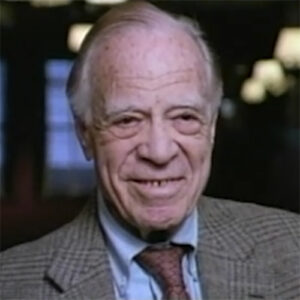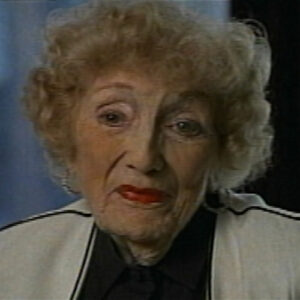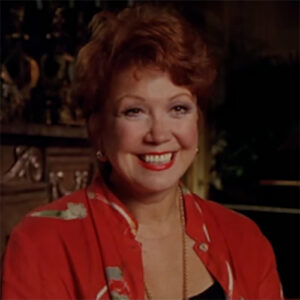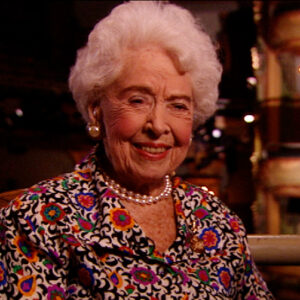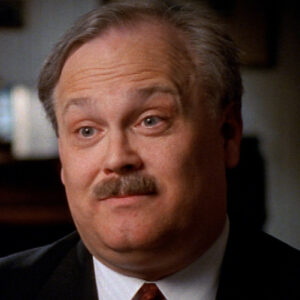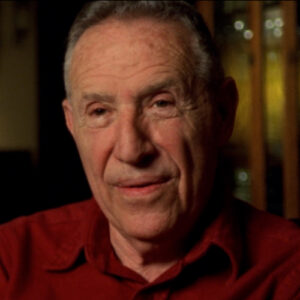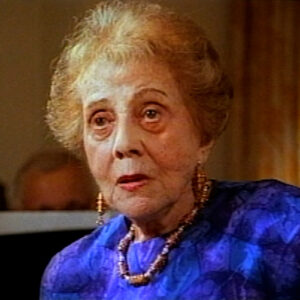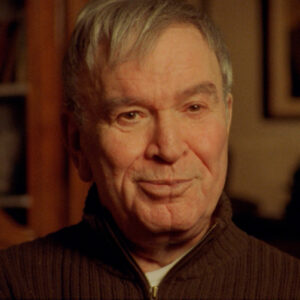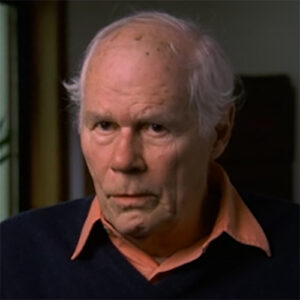Interviewer: We’re always talking about the musical here, it’s facing.
Frank Rich: Well, Broadway box office is actually not booming. In the period since September 11th and then after the war in Iraq, Broadway business was as bad in terms of seats being filled, whatever figures are presented by the promoters, as I’ve seen in my lifetime. And there’s a fundamental change now going on with Broadway economics, where people are not buying tickets in advance. And it’s basically easy to get into almost any show on Broadway, including even the biggest hits for that reason. As a consequence, there’s less money around. And that means nothing good for the musical. It means that musicals are very expensive to produce. And they’re all out of proportion in terms of the of getting a return. At the same time, ticket prices can’t be raised much higher because even in real dollars, they’re up by almost 100% over the past 40 years. So the musical’s in a real bind. And what that means is big corporations come in as they have, corporations like Clear Channel and Disney. Safe shows only. Safe shows, they can be good or bad or indifferent, but they’re revivals, or they’re based on something that can be branded, often the name of a popular movie from the past. And they rely essentially on performers and creative talents that these corporations feel are either proven or will go along with the program these corporations have in mind for mass entertainment. So for the first time, the Broadway musical has been hit by the kind of cookie-cutter mentality of these large entertainment corporations that have taken over many other aspects of show business, music business, the movie business, even book publishing and journalism to some extent over the past 10 or 15 years. So it’s a seismic shift. New talent finds it almost impossible to come up. Occasionally, someone will slip in, but only occasionally. And so it’s very hard for the next generation of Sondheims or Kander and Ebbs or Bach and Harnix to come along.
Interviewer: You know, I think of Jonathan Larson as that kind of independent guy who just happened to… I mean, has it been pretty much since then that the corporate world has really seized the…
Frank Rich: The corporate world sees Broadway beginning really with Disney’s arrival, particularly with Disney beautiful reconstruction of the New Amsterdam Theater and opening it with a big hit, The Lion King. While movie companies have been in and out of Broadway really for much of the 20th century, this was the first time that they really struck a geyser. In terms of a huge return on investment. And this emboldened, I think, other companies, some of which are not even as close to show business as a Disney, to come in, like Clear Channel, which has money in shows like The Producers and Hairspray, largely out of the feeling that these are known properties, likely to work, easy to sell, and can be reproduced easily on the road. When someone like a Jonathan Larson came along and ran if we’re just at the beginning. Of this changeover, he didn’t come through Broadway. He was hired by New York Theater Workshop, a relatively small non-profit theater, had a success, and then commercial producers moved it. But if Jonathan Larson had gone with a score of rent under his arm and tried to get it done by a Broadway producer, there’d be no such thing. And indeed, he had spent, he wasn’t a kid, he had spend years trying to get a show on without success. Rent happened, and of course tragically he died as it did happen. And so that was turned out to be a cul-de-sac. And since then, a lot of young songwriters have maybe had work off Broadway as they always have, but even the great ones aren’t necessarily moved. I mean, an example would be Adam Gettle, Richard Rodgers’ grandson, who many people, including me, feel is perhaps the most talented young composer the theater has seen in years, he’s around 40 years old. He’s never had a show on Broadway. He’s had successes off Broadway and in regional theaters around the country, but it’s possible that unlike his grandfather, who was the king of Broadway for decades, he may never show up on Broadway and infiltrate this world of the hairsprays and producers and Man of La Mancha and Kiss Me Kate revivals.
Interviewer: You know, why are we essentially here? What is a Broadway musical and why is it so thrilling?
Frank Rich: I think a Broadway musical at its best is this really particular and idiosyncratic form of very American entertainment. Sometimes it aspires to be more than entertainment, but at the gut level, it’s this smorgasbord. It’s this melting pot of cultural elements that include, obviously, music, also usually script, drama, dancing, an orchestra. People who really can just sing and not act, sometimes, but not exclusively spectacle. And it’s all, to me it’s so much a product of New York, so much of a product of New york in the 20th century, in the way these elements just come together and in the best musicals gel and add up to much more the sum of their parts. It’s hard to, it’s hard explain in a way to people who haven’t seen one. And not only are they, generally speaking, not captured on film, but film has the perverse effect of flattening them out. And while movie musicals can be great, generally the great ones are not adapted from Broadway musicals, and they have their own thing going, which is related to, but different from the theatrical experience. You feel part of this community of magicians, if you will, that many of whom you don’t see, who are moving scenery or are in the pit. Or backstage, changing people’s wigs, whatever. But you have a sense they’re there. And then you have this sort of pulsating energy of the performers doing all these things and moving usually very, very quickly to keep the whole thing floating on air. Now, there are other formats. Some people, such as Stephen Sondheim would be an example of this, have played with the form and slowed it down, sped it up, told it backwards. Added other elements of stagecraft and can seek to it, but when all is said and done, it’s that amalgam of all these elements, artistic elements that make a musical tick, no matter how individual examples of the genre may vary.
Interviewer: At its best, how does it affect you, or what can it mean to a person?
Frank Rich: I feel while musicals, while some musicals can and do mean, actually mean something in terms of their content, I mean there’s definitely a, you can get an emotional feeling from great drama in a show like Porgy and Bess or Sweeney Todd or Oklahoma or Carousel, there’s something beyond that dramatic content, the story in the… Characters, it’s this kind of exhilaration, I think, that’s of energy, just sort of flying on the wing. And you grabbing it and knowing that it’s going to pass by in an instant, it is going to be completely evanescent. And you have this experience that can never be duplicated in the same way again that might involve 50, 60, 70 people when all is said and done, on and off stage, pulling together and creating this intangible excitement that then is gone. You know, you look at a musical like A Chorus Line. A Chaurus Line was a musical that was considered in the mid-1970s to revolutionize musicals in some ways because it didn’t have a lot of scenery. It was set in real time. It didn’t really have a story, except it was just about an audition. It didn’t have a star, all those things that were thought to be essential for musicals. But what it did have that I think captivated people and captures the spirit of every musical is that you had this dark empty stage and you had a cast of singers and dancers materializing on the stage, creating all this excitement with smoke and mirrors and their voices and their bodies and everything else And then… At the end you’re back on the empty stage again and you say to yourself as you’re leaving the Schubert Theater, how the hell did they do that? How did they create this excitement wearing work clothes with no scenery and that I think stripped down to the essence of the musical that lives even if the specific story a chorus line told about an audition, you can like it, not like it. It’s not the greatest story in the history of the world, it’s perfectly fine, but it was that ability of Michael Bennett, in this case, the director-choreographer. To create that excitement with like rubbing two sticks together and show what that pure musical theater excitement is.
Interviewer: Is there a favorite show that you wished, you know, Jeff Ward of Ken Burns, he wished he’d seen the Wild West show, Buffalo Bill’s Wild West Show. Is there one that you just, you know say, God, if I don’t even been there on that night, or.
Frank Rich: Oh, there’s so many. I mean, I wish I had seen every show. Well, not every show, but many of the shows that I’d missed either before I was born or when I was too young to see them. I would have loved to have seen the original production of West Side Story, which I just missed. I would’ve loved to see the original productions of the great Rodgers and Hammerstein shows, such as Oklahoma, Carousel, and King and I. And, like many people who miss them assiduously, try to find. Any evidence of them, because evidence does exist, scraps of film, recordings beyond the original cast recordings, but they’re gone. And that’s part of the mystery and lore of it, that they are gone. And so they can’t be brought back in that form. They can be revived very well, obviously.
Interviewer: I’m trying to bring it back in my own little form.
Frank Rich: No, I understand. I mean, to make your task more difficult.
Interviewer: Let’s talk about, you mentioned West Side Story, let’s talk about Jerry Robbins.
Frank Rich: Sure.
Interviewer: Without naming his shows, without being too specific, what did he mean to the musical? What was his genius and contribution?
Frank Rich: Jerome Robbins began, or maybe he didn’t officially begin it, but he was the apotheosis of the idea that someone could direct and choreograph a Broadway musical, that they weren’t two separate jobs to be given to two different people, but that the whole thing could move as one, and that even if you’re having an actor crossing a stage and not dancing, it’s part of the look, the feel, the dramatic tension of a piece. Other people had done it. Before him, for instance, Agnes DeMille and some of what Robbins did built on DeMilles. But that said, Robbins took part of the DeMill idea which was that dancing can have character, that dancers can express emotion, they’re not just there as decoration to come out in a chorus line and amuse you. And he took things like the idea of the Dream Ballet, which was Demille’s in Oklahoma that sort of revolutionized Broadway dance in the 40s, and applied it to the whole piece. Maybe in a show like West Side Story or Fiddler on the Roof, every chorus person, even someone who didn’t have a specific line or had one line, had a character, was named in the playbill as a character. Struck an attitude whenever he or she crossed the stage or appeared in a dance. It wasn’t a bunch of anonymous. Dancers anymore and meanwhile the entire work was choreographed in the way that you might choreograph a serious dance piece even though inevitably would have to stop for dialog. He created this revolution really doing very few shows and after Fiddler on the Roof in 1964 which was the prime of his career he quit. I mean he never returned to Broadway except to do an anthology of his own past dances. He went into the for real into the serious ballet in City Ballet. Which he had been doing for some time.
Interviewer: That’s a big moment for us, and I want to sort of set that up in the next question, but take us to West Side Story and just briefly speak to his amalgamating the traditional elements, dance and music and so on, how did he make West Side story into something so important?
Frank Rich: West Side Story is a landmark for a number of reasons, and not just because of Jerry Robbins. It was, after all, the first attempt in years, and maybe the best attempt up to that time, to do a contemporary story that dealt with big social issues. There was a history of this in Show Boat and Porgy and Bess, but there wasn’t a lot of it at the time West Side Story came along in sort of the complacent 1950s. It was very seriously written and composed. What Robbins added to the mix was first of all showing his hand at the very beginning of the show with an electrifying dance piece for the opening number telling the audience that I, even more than these terrific writers, Arthur Lawrence, Julie Stein and, excuse me, Arthur, Arthur Lawrence Leonard Bernstein and Steve Sondheim, and setting the pace of the show by telling you how these jets. Yes, they’re singing a song that’s a terrific song, but they are moving this panther-like action with this excitement, and that in itself is telling you the drama of the evening. It’s not someone singing, oh, what a beautiful morning, and setting the tone, and it’s not a bunch of chorus girls just saying, we’re going to have fun and doing a little dance. Then throughout the show, there are moments that can only be described as cinematic. Tonight, at one point, becomes a quintet. With five different pieces of action, different people singing different versions of the song against each other, and the way that is staged and was something different. Before, you might have a duet. You might have an in-one number with people spotlighted in front of a drop or something. But here they were on the move. It was a moment of heightened tension in the story of West Side Story. And with a combination of brilliant lighting by Gene Rosenthal and obviously the Bernstein Sondheim material, but Robbins moving people in and out and these all sorts of incredible orchestrations, you had a sense almost of film and indeed West Side Story is an example. All the film is one of the better adaptations of Broadway musical and while Robbins was involved with it, when it’s just reduced to regular cinematic cutting it’s not nearly as interesting as it was on stage.
Interviewer: What about, in what sense is Fiddler an end of an era for Broadway? Because at that point, you mentioned Robin’s quitting. There’s a few shows that year that
Frank Rich: I don’t think, I don’t agree with the premise that Fiddler was the end of an era. I mean, I’ll give you, Fiddlers was the the end an era in the sense that it was Jerry Robbins’ last show as a Broadway choreographer. But by then, there were a whole bunch of disciples following in his wake, including, very importantly, someone who wasn’t a choreographer, a director, Harold Prince, who had produced and had been a co-producer of West Side Story. And they took his ideas and just ran with them. And so if Fiddler was in 1964, it’s a direct line from Fiddlar to Cabaret in 1966, which Hal Prince directed. And while he did it in collaboration with the choreographer, since he wasn’t one, it very much was a Robbins-esque vision. And I would add a leap in sophistication material from Fiddler. Ultimately Sondheim, who of course had worked with Robbins on both West Side Story and Gypsy, would join as a regular partner with Prince and they would take the Sondheimer ideas and push them further, even if in a show like Sweeney Todd say they didn’t involve any dancing to speak of, but the idea that a whole show would be choreographed as a piece. Now, simultaneously with this… In that 1964 period, it was the period of Hello Dolly, Funny Girl, although Robbins had, of course, an involvement in Funny Girl. But I think even Robbins would say it was a fairly standard musical that he came in and doctored. And that tradition actually would continue, but become a little bit, be a little of a second. Both these traditions would continue. The Robbins serious musical tradition, the idea of a completely integrated show in terms of its staging. But at the same time, the sort of frivolous musical that was a throwback to the 20s and 30s would continue out of the Hello Dolly, funny girl part of 1964. And you’d see it in shows like Annie, for instance, which would be simultaneous with the Prince Sondheim, Sweeney Todd. You see it now in shows like. Hairspray and the Producers come, first of all, they’re set in the early 60s and they even pay specific homage to shows like Hello Dolly and Funny Girl and Bye Bye Birdie, which Hairsspray resembles in many ways, the frivolous but often wonderful musicals that were frequently directed and choreographed by Gower Champion, who also integrated a whole production but with a different end in mind. But basically, those two branches continued and continue. Until recent years when the whole musical seems to be collapsing into sort of tourist theme park attractions.
Interviewer: Speak if you would, let’s jump to one of those strands, which is where company kicks off. Well, why is company, would you say a landmark of a sort? It begins in a very important body word.
Frank Rich: Company is an extraordinary show. It came in 1970. Keep in mind that it was a meeting of several forces. One was Sondheim had not had a show on in six years at that point. He had not a show since a failure called Anyone Can Whistle, an experimental musical in 64. How Prince had reached his sort of heyday as a director. He had begun as a producer, but he now had several shows under his belt, including company and, excuse me, including, several shows under his belt including Cabaret and Zorba, which were sort of pushing Jerry Robin type ideas of staging further. Add to the mix Michael Bennett, a very young choreographer, former Broadway gypsy, who’s talent was recognized very early and had been staging things that work. On a couple of musicals as well as in television. They all come together, and the piece that they decide to do is a group of one-act plays by a playwright, George Firth, that were not written as a musical. They were sort of written as an evening of one act plays. And everyone sort of said, wait a minute, we can create, I’m sure they weren’t thinking we can something new, but we can create something good where we don’t really have a plot. We have one central character. From whom radiates all these other characters, and as many people know, it’s a show about a single man who can’t commit to marriage and his married friends. And that the setting of the show would be New York City, not specifically the Upper East Side or Greenwich Village or someplace you’d represent realistically, but actually is abstractly designed by Boris Aaronson, almost a series of platforms that gave you kind of a view, an abstract view of New York. I saw the show in one of its first public performances, if not its first public performance, in its tryout at the Shubert Theater in Boston when I was in college, and it was, it was shocking, shocking in a pleasurable way, but no one had ever seen anything like it, and indeed it was often misunderstood by critics, and I remember, I was so taken with it, I wasn’t in high school and I was visiting Boston in the fall of 1966 for college interviews. And I was with a theater-minded friend. And there were two shows running in downtown Boston. I Do, I Do was trying out with Mary Martin and Bob Preston. At the Colonial, at the Schubert was a show called Cabaret about which we knew nothing. It had just opened in Boston. This was a Saturday night. It had opened like that Tuesday night. I hadn’t been in Boston and seen any reviews. There was no ads yet in the New York papers. And how Prince had never… Directed a show of any prominence before I knew him as a producer and of course people like Joel Gray were not stars yet and what interested us was that Lottie Lenya whom we associate with Kurt Weill was in it so we go to the Schubert to get tickets and our surprise sold out because it didn’t have Mary Martin and Preston in it we go a broker we sort of pool our resources we get seats in the last row of the orchestra, the Schubert and Boston. And we get in just as its beginnings, we don’t even have a chance to look at the playbill. It begins with this drum roll and then this, what seems to be an empty stage with just a trapezoidal mirror that reflects the audience before any, before a chorus line, before anyone had thought of this, where you can see the house, but an empty state and then it begins with a drum roll, as I recall, blinding lights along the footlights that sort of give you a temporary blindness as a member of the audience. And then the sky. Joel Gray, but made up in a way that even if you knew what he looked like, he’d be unrecognizable, comes out and starts singing a song that we all know now is Wilkomen. But my friend Sarah Fischko and I looked at each other and said, is this show in German? We didn’t know what it was. Then the show proceeds and I would learn years later, this was a somewhat different It would be refined by the time it got to New York. Well, I would have learned it when it came to Newark. It was in three acts then, it had… Very bizarre dream sequences that were ultimately cut, but it was absolutely, you felt you were seeing something completely new. It had a stronger effect on me than Fiddler, which I had been present at the creation of two years earlier had, or Hello Dolly, which I’d also been present at the the creation of. It was, and it was, during intermission and after the show, as we’re leaving, we’re talking about it a mile a minute, And we can’t even quite describe what we… We’re seeing. We knew the period. We were familiar with Weimar Germany. We got the references to Brecht and Weill. But that said, this was very much a glamorous Broadway musical that was about the collapse of a society and about the Nazis taking over Germany and told through song, dance, and this sort of recti and alienation effects, and fantastic stagecraft. Some good acting, not uniformly good acting. And it was mind-blowing, and the audience was baffled. And of course, it still had a line in the show that ultimately they would chicken out and cut before they came to New York in a Joel Gray number called, If You Could See Her Through My Eyes, when she dances with the gorilla, the song ended with the line, she wouldn’t look Jewish. And people took it as anti-Semitic and were shocked by it, which was not the point, obviously. It was about Nazi anti-semitism, not being anti- Semitic itself, but actually they took that line out before it even opened on Broadway. So it was very out there and it had all this sort of androgynous sexuality and obviously a great score by Kander and Ebb, who at that point were hardly known. They’d done an unsuccessful show, floor of the Red Menace that Prince had done. And not directed, George Abbott had directed it, and they were, you know, they were not famous and we wondered, could this show possibly be a hit on Broadway, and in fact it was, in spite of the fact that not all the reviews were good, and although Walter Kerr then writing for the Times gave it a pretty sensational review and got it.
Interviewer: Place us, you know, in the mid-60s with real counterculture, protest, and in comes a show like Cabaret, and then, you, know, take us to company. These shows about marriage and the culture shifting here.
Frank Rich: Well, the culture is definitely shifting, obviously, in the 60s, and in the late 60s in particular. And the edge of those shifts can be seen in Cabaret. Prince has said that he was inspired in his treatment of sort of the social unrest by some of the civil rights demonstrations and the war about civil rights that was going on in the Deep South at the time the show was in preparation. But Broadway is a… Was basically trying to ignore the 60s. And so while you had this pocket of unconventional writing and stagecraft and shows like Cabaret and then Company in 1970, you’d be hard pressed to argue that many people connected it to the 60’s counterculture and indeed as a college student in Boston during the late 60s. When both Company and Follies tried out at the height of the Vietnam War and the Cambodian invasion, the campus I was on was in revolt, and I was in the school paper and writing about that revolt. I could never get anyone to go with me to see those shows. Some of my friends regretted it later on when they became historically important, but it was really the beginning or the consummation of Broadway musical falling out of sync with pop culture. Essentially the fact that Broadway not only didn’t take note of social developments, except when they could figure out a way to exploit them, like finding hair in the East Village and moving it to Broadway as sort of a tourist attraction. I liked hair, but that was not something indigenous to Broadway, except for something like that. The typical musical of the High of the Vietnam War could be something like How Al Dow Jones, you know, or George M. Shows that are promises, promises that have absolutely nothing to do, they may be good or bad or whatever, but they had absolutely nothing do with the main culture of the moment. And of course, behind all that is it was really the advent of rock and roll that pushed Broadway musical out of the mainstream of American culture, because up until rock role. Broadway music had been the top 40, the top 10 hit parade music of the country and that started to change obviously in the late 1950s and by the late 1960s it was a done deal. And so Bert Bachrach and Hal David could write actually an enchanting score for Promises, Promises and that would be about as hip in terms of rock music as Broadway would allow itself. Even hair wasn’t written by, it was written by an older… A very good, but conventional composer, Galt McDermott. There was no attempt made to recruit a Simon and Garfunkel or a Laura Nero or one in McCartney, whomever, who might have bridged that gap. And so they essentially lost a generation. They never recovered from that.
Interviewer: Start with Company, if you would, and what do Prince and Sondheim do to, you know, the kind of optimistic, the traditional notion of a Broadway musical ending optimistically and the journey of, and also just structurally, between Company and Sweeney Todd, their experiments help to push, maybe not mainstream Broadway, but they create a certain avenue.
Frank Rich: No, Sondheim and Prince created a series of shows, none of which were as commercially successful as the wonderful, frivolous show they did early on. Prince, of course, is a producer, not director. A funny thing happened away at the Forum. To this day, Company, Folly, Pacific Overture, Sweeney Todd, none them make the kind of money that Forum did and still does. That said, the shows were often successful enough. Often but not always profitable. Follies was a complete financial flop on Broadway and never toured, for instance. And for a small, by American showbiz standards, but ravenous audience, they created a musical that gave you something to think about at times, in addition to supplying, in my view, wonderful songs, drama. Terrific storytelling and storytelling of a different sort, not a kind of who shot John storytelling or will the guy get the girl, but how the guy fails to get the girl or how the guys murders the girl or how the guide married the wrong girl and had a nervous breakdown because of it. And these were adult themes. They were, however, you could argue, in the tradition of Sondheim’s mentor, Oscar Hammerstein in that. Carousel is in the, you know, a lot of laughs. It’s a great show in my view, but it does have suicide in it. It has wife beating in it, and I feel, you now, even something that not one of my favorite R&H shows, like Sound and Music, was about the Nazis, to some extent, and escaping the Nazis. So, and you could even argue that Pacific Overtures, which is essentially a show about The opening up of Japan by imperialists led by America is a gloss on the King and I, which dealt with some of the same themes 30 years earlier. So it isn’t entirely new. The storytelling techniques are very new because they didn’t feel you had to have the conventional beginning, middle, and end. In fact, it became sort of a cliche of the Prince Sondheim shows that they ended where they began. Company begins and ends with a birthday party, Follies It begins with people arriving at the theater, ends with them leaving, but it’s sort of the same thing. So they really, merely the roll-on goes from the end back to the beginning. So there is a kind of playing with storytelling that’s very inventive and exciting. They’re having a huge fight right now about exactly that issue.
Interviewer: I know you have feelings about Sunday in the Park, which we’ll do in a minute, but is Sweeney, you used the word apotheosis. Is Sweeny the culmination of a certain kind of sun?
Frank Rich: No, I would say that if you look at the Sondheim musicals, they all build on the ones that came before, and yet they’re all very different because they never repeat a milieu, they don’t repeat characters, and so on. Sweeney Todd was only, I think, an economic culmination. It was done on this gargantuan scale in Broadway’s largest house. And you simply could not find the money after that. To put on a musical that serious at that scale. It just can’t happen. Sweeney Todd can’t get a full Broadway revival. He can get a stripped down Broadway revival, but like Follies, you simply can’t afford to do it anymore. That many people on stage, that kind of scenery, that full band in the pit, and that was sort of the end of it. Sweeny Todd was a hit, but it wasn’t a huge hit. It cost so much to run that it made money. But compared to a chorus line, or cats, or something like that, it’s very small potatoes in its profit, because it cost so much to put on. And so what would happen after that, I think of subsequent Sondheim musical that was daring, whether it be Merrily, which didn’t work originally, or certainly Sunday in the Park with George, the idea that you do it with 40 people on stage and all those people in the pit, that was over. That was over unless you’re going to do Les Mis.
Interviewer: Revolutionary chorus line was in his time, and how this is perhaps the darkest days of the Broadway musical. Jerry Schoenfeld said, you know, this place was a sewer.
Frank Rich: By the 1970s. Broadway is in terrible shape for all sorts of reasons, some of them intrinsic to the theater industry, but some of the also extrinsic. Drop dead period of, you know, New York itself was going into bankruptcy, so everything was down. For the Broadway musical, it was essentially, tryouts had essentially, were about to end. When I was growing up, and for the entire history of the Broadway, the modern Broadway theater at least, plays and musicals alike were taken to a fairly select group of theaters out of town, particularly in New Haven, Washington, Philadelphia, and Boston, and a few other cities, Detroit. And they got out their kinks and the creators could work on them there. They’d see them before audiences and they’d rewrite the second act or try to find a new song and these latest shows like Fiddler on the Roof and Hello Dolly were done under that system. By the time we got to the financial problems of a decade after that in the mid-70s, you couldn’t afford it. Shows were becoming heavier technologically, computers had come in, costs were going Money for production was down, and so there was no real system to develop a musical, yet no one wanted to roll the dice and put up a multi-million dollar show without having tried it out. So Joe Papp, this visionary impresario in the non-profit Off-Broadway Theater, the founder of Shakespeare the Park, and by this point an indoor theater called the came up with the idea of letting Michael Bennett a promising, but yet-to-be-superstar director, choreographer, work on a project in a rehearsal room or in a stage downtown in what’s essentially the East Village, and develop a show from scratch. Now keep in mind, if the show had been My Fair Lady or Hello Dolly, it wouldn’t have happened that way because Joe Papp couldn’t afford to have the Ascot Gavotte or the Harmonia Gardens or any of that, but this was a show that was set in an empty theater with people in rehearsal clothes. And so, and it was also a show being developed from documentary materials, tapes of reminiscences, audio tapes, by Broadway gypsies about their life in the theater. And so. He had a lot of time and very little expense to keep performers on at a very, I’m sure, low pay scale and develop this show. And then without the pressure of immediately putting on Broadway, it was done at the Newman Theater, I’m guessing a 300-seat theater with a proscenium shape that was one of the stages of the public theater. It was a very interesting phenomenon because they started playing at the public theater. And I remember this vividly. It was. At the half-price ticket booth, even though it was already a cheap ticket because it was an off-Broadway ticket. And I went down and saw it the first week, not knowing much about it at all. It was written by Marvin Hamlisch, obviously it had no stars, clearly. And it was so amazing, it had had no intermission, and you saw a lot of people doing just what I did as soon as the show was over, going right to the box office of the Public Theater and buying for a subsequent performance. And they never opened for weeks. They didn’t open it. And suddenly it became the hottest ticket in New York with no reviews, just word of mouth. And by the time it in fact opened, this was before I was a drama critic, I’m pretty sure Walter Kerr reviewed it for the Times, it was already a hit and it was like a coronation of something that was already accepted as a smash hit. Then it would ultimately move to Broadway, to the Schubert Theater, and have another opening that was really just sort of ceremonial coronation because the thing was on sheer… Word of mouth, wouldn’t have mattered what the critics said. That then introduced this system of trying to workshop shows. But most off-Broadway theaters don’t have the money or resources that Papp did. He was the biggest off-broadway theater in terms of infrastructure and money and everything else. And so Broadway producers, not wanting to take shows out of town, created their own sort of informal workshop system where they would do semi-stage productions without scenery in rehearsal halls in New York. To see if it’s worth going on. And in recent years, that system has dried up a bit, A, because Broadway musical production is down terribly anyway, and there’s no money for anything, but B, because it turned out to be not so successful a system. There were some, there’ve been a series of flops, such as Sweet Smell of Success, that everyone said looked fabulous in a workshop, and then they took them to Broadway, and they died anyway, so it’s not clear. Maybe if you don’t have Michael Bennett. You can’t create something from scratch in a workshop so easily. It’s not technically the first show I cover, but it’s the first big show. Forty Second Street.
Interviewer: Places as you’re a you’re young. Right. There was a lot riding for you.
Frank Rich: Yeah, in the spring of 1980, when I arrived as a second string critic, at the Times, with a sort of vague beat. The system on Broadway was that all shows were covered in previews, because by then shows almost never tried that out of town, and they had so many previews in New York, the system became and it persists to the present day, that two or three performances by the end, they just freeze the show and invite the critics in. But there was one aberration in this system, and that was David Merrick. David Merrick was the producer that I sort of grew up with. Not that I knew him, but I grew up in a tryout town, Washington, DC, where Merrick would literally rent the one legitimate theater in the pre-Kennedy Center days, the National Theater, for the fall without even knowing what shows he had. And so all his shows were at tryout there. I haunted that theater. I ultimately became a ticket taker at it. And his stuff like Hello Dolly and The Bombs, too, like Pickwick, they all played Washington and I would see Merrick around the theater working on these shows. Here it is some years later after that heyday of his and my teen years, 15 years later, I’m a Times drama critic and for the first time in years he’s producing a new show. It’s 42nd Street. He’s trying it out again in Washington at a time when people weren’t trying out, this time at the Kennedy Center. He’s reunited with Gower Champion, who did Hello Dolly, I Do, I Do the Happy Time and others for him. I’m back in Mabel. And I’m not going to review the show. The critic of the times, the first-time critic is Walter Kerr. However, Merrick decides he does not want critics to follow the usual system of reviewing in a final preview. He, in fact, is having previews. But he is declared that critics are going to come on opening night, come hell or high water. The Times and other newspaper positions, what the hell with that? We’ll just buy tickets for the last preview. We’re not going to let a producer tell us how to cover a show. So then, and this is the kind of balls that Merrick had, he starts canceling previews, which is a gutsy thing to do because it costs him money. He has sold tickets for that night. He’s paid the cast. So he’s losing thousands and thousands of dollars. There’s a lot of producers. Such as were left at the time, talk a big game, but they won’t put their money where their mouth is. He did. So the writing becomes on the wall that you’re going to have to cover opening night. And Walter Kerr, who had been recuperating from an illness, tells the Times he’s not going to do it. I, meanwhile, had been in a car accident, was sort of recuperating, and I was told I had to do. And I felt a tremendous amount of pressure. I didn’t want to write on opening night anyway. And um… And certainly not for the biggest show of the year. So it’s August, a time when Broadway shows never open, another peculiarity of Merrick’s approach to the 42nd Street issue. And I go to the show, and before I go, the press agent for the show tells me, as he presumably told all the press, a couple of things by phone. One is that I should stay through one curtain call, not run up the aisle the way critics would on opening night, just through one curtains call. And secondly, that there would be cabs waiting outside the Winter Garden Theater, where the show was opening at 50th and Broadway, to whisk us back to our various newspapers. So I’m watching the show, and I have this sinking feeling. I thought the show is mediocre. Not terrible, but not great. And I’m thinking, oh god, I have to write this review that’s going to be a mixed, or possibly even a mixed to negative review. And I have write it on deadline, with the whole looking at me and everything else. The show ends, we stay through one curtain call. That curtain calls over and my wife and I head up the aisle. As we’re in the outer lobby of the Winter Garden and heading towards the street, I’m stopped by a man I know in the movie business who had worked at various times with Merrick. He says, Frank, I’ve got to talk to you a second. And I said, can you call me tomorrow on one deadline? By this point, my wife is on the street where she’s discovered there are no calves waiting, and she’s frantically trying to hail a cab so we can go back to the times. He said, but you don’t understand. He said Gower Champion is dead. And I said, what? And Garrett Champion had directed the show, was a man in his mid-50s, and there had been no rumor that he’d even been ill. And he had been actively seen in Washington directing the show. And I thought, is this a hoax? Merrick was famous for his hoaxes? Or what the hell is this? I go out to the street not knowing what to do. I don’t even know who to find at the times to check it out. I can’t play boy reporter. I have a review to write where there’ll be one ancient night copy editor dealing with my copy. My wife has not heard this exchange and thinks I’m having a breakdown because I’m sort of frozen on the sidewalk. I get into this checker cab and start to explain, and just as the cab is about to pull away and I’m shutting the door, I see coming out of the theater Arthur Gelb, my real editor and his wife Barbara, and I start screaming. And as Arthur would later tell me he thought I was having a break down too, I say, he said, what’s wrong? Go back and write the review. And I said, well, someone just told me who might know some of the Gower champions. And he said, well, that’s impossible, but he throws Barbara in the jump seat. He gets in. Let’s go back to the Times together. We go the eight blocks or whatever it is back to The Times. As we walk into the third floor where the Culture Department then was, this empty news room in the days when phones still rang, every phone in the culture and arts and leisure part of The Times is ringing because there had been a bunch of Times reporters and editors at this opening. About five minutes later like at the ninth curtain call Merrick indeed announced that Garrett Champion had died. It turned out he died not that recently. Merrick had kept it secret. He had died, one was later one of a very, very rare blood cancer, and had died in Sloan Kettering. And the cast hadn’t been told, no one had been told. But he had made sure, Merrick made sure all the press was there. And we stopped the press run of the first edition to slap a picture, my review couldn’t be ready yet, on the front page. Of Champion saying, as Arthur Gelb wrote the caption, David Merrick announced that Gower Champion had died, not that Gauer Champion was dead because we didn’t trust Merrick enough to, you know, he could have been making it up. Ultimately, we got confirmation. I wrote my review, got it in, and wrote really one of the, maybe the only review of 42nd Street while I was a big fan of Champions and some of his work in the show was not favorable about the show. But this is what made Merrick a brilliant producer. No one cared anymore. It was front page news all over the world that he had announced Champion’s death from the stage. And even people who didn’t know what 42nd Street was or who Gower Champion or who David Merrick was, they all knew it now. And that show went on to run as long as Oklahoma. And it was revived on Broadway. In fact, it’s running on Broadway as we speak. I saw it again. And it’s the same mediocre show I remember from then. But who cares? It doesn’t matter anymore.
Interviewer: Was he sort of a last of a certain kind of breed, Merrick?
Frank Rich: Absolutely.
Interviewer: Give that an atomic sentence, rather.
Frank Rich: David Merrick was the last great Broadway producer. In this way, in several ways, first of all, he often, not always, but he often created shows from scratch. He’d have an idea, a musical version of the Pagnole plays, it became Fanny, that was his first hit. A musical version of The Matchmaker which he had long previously produced as a straight play, it became Hello Dolly. He would assemble the talents and in the way of a. Of a really tough manager, knock people’s heads together to get the show he wanted. He would bet everything on it. As the years went by, he increasingly cut out investors and put up all the money himself. He certainly did, I believe, for 42nd Street. And some of them are huge flops. But even the flops, he would try to sell. And they’re many legendary stories about him that I grew up with. To me, he was part of the glamor of the theater, taking fake ads with fake quotes in them, putting for Fanny, putting sort of nude pictures in men’s rooms in New York hotels to get people to sort of think it’s a sex show and it was basically, you know, a Harold Rohn musical with no sex in it at all, maybe had a belly dancer, I can’t remember. He would stop and he would do publicity stunts that would humiliate his own stars when Jackie Gleason. Started missing performances at the height of Gleason’s fame in an American musical called Take Me Along in the late 50s. He’s, Merrick Woodholt Press Conference is challenging Gleeson’s veracity and goading him to returning to the stage. He was a nasty guy. He was mean guy, but he was a promoter. And he loved the theater for whatever reason. I don’t think he loved anything else from what I know about him. And I got in the very tail end of his career, after 42nd Street opened, he tried to place an ad with his little agate ads, agate-type ads on the front page, bottom of the front-page New York Times that read, Broadway producer seeks arsonist to burn down major metropolitan newspaper. It was stopped by the advertising accessibility department before it got in, but sometimes he would slip ads like this into various newspapers, including ours. And all of it accrued to his shows in the form of publicity. What succeeded him is not the same thing at all. The producers we have now are either people who go shopping. They don’t produce things from scratch. They go to London, or they go to off-Broadway theaters or regional theaters, and they say, oh, that’s a wonderful revival of Death of a Salesman. So I’ll bring it in the Goodman in Chicago. I’ll be into New York. That show was a big hit in London, Mamma Mia, so I’ll bring it to New York, whatever. That’s not producing. Also, producers now generally are not a single person. It was David Merrick Presents and that’s it. Look above the title of any Broadway musical now and you can see as many as 12 people. They’re money people, sometimes in legal corporations. They’re having fun, but they’re not the real power behind the show. To me it was, Sunday in the Park with George was a watershed event because of its daring and its quality. Not everyone agrees with this opinion and in fact, as a critic, I was one of the very few people who gave it a good review when it opened in the mid-80s. It was, it was panned by a lot of critics and was not a commercial success. But I felt it was some sort of apotheosis of Sondheim’s work. It was this. Very intense, very personal show about a guy, in this case the painter Georges Seurat, who is locked in into the creative process and his passion for his art and excludes the real world, including the woman who’s in love with him. At the same time, it really was a Broadway musical about. How art is created and how even a musical is created because much as Sera and his painting used pointillism, dots of light and color that only from a distance would add up, Sunday in the Park is a composition both in terms of how its book was written by James LaPine and particularly how the score, lyrics written by Sondheim, does the same thing. It keeps layering on elements that are, that seem pointillistic, that seems self-contained anecdotes, self- contained musical phrases in terms of the music, even lyric words like dot that reappear, and gradually it all comes together in the first act to form a complete picture of the relationships of fictional characters in a musical at same time Sirad’s masterpiece that hangs in the Art Institute of Chicago, the Grand Chate. Comes together as a painting. And the end of the first act of that show is, to me, the most electrifying curtain moment in any Broadway musical in history. The only one that can even compare to it, in my view, may be The End of Gypsy. But even then, that comes to a culmination with Rose’s turn in, and there’s a book scene. So it’s not quite this incredible cuda teatra. Then it’s the first act of Sunday in the Park. The second act, which some people find very problematic, which I find mildly problematic, isn’t at that level. But still, to me, in the end, he pulls it out. And if nothing can ever top that first act ending, he finds a way to bring it full circle and bring his musical, emotional, storytelling themes all together and send you on your way. It’s not, it’s a show that a lot of people hated, at least at that time. It’s gradually found acceptance. The night I went to review it, it was a theater party audience and a lot people walked out at the end of the first act, which just goes to show why, as a critic, you can’t be affected by the audience around you. People always say critics, everyone was cheering. Well, of course, most times critics go, it’s the backers and they are cheering. And why didn’t you report that? Because it’s meaningless, just as when people are walking out all around you, if you’re moved to tears, as I was by Sunday in the Park. You have to go with how you respond to it. Well, the thing to remember about the 20s, which was the height of Broadway production, Broadway production nearing almost 300 shows a season by the mid to late 20s. A lot of things exploded at once. First of all, indeed the creation of the modern pop song arguably beginning during the World War I era with Alexander Ragtime’s band in Irving Berlin and then all the the greats we know now, joining him in this huge explosion of song in the 20s. It was also, one might add, the beginning of adult modern American playwriting in the form of Eugene O’Neill. It was the jazz age. It was a time of tremendous growth for New York City. It was, also, a time for tremendous emancipation of women and a whole change in nightlife to New York. Once women were allowed to step out, not only with men, but on their own and become part of an audience, whether it be, or go to restaurants on a company. I mean, this was all new stuff by the time you get into the 20s. Tin Pan Alley was a thriving thing. Sheet music was happening. Radio was invented in the early 20s and, of course, recording whatever cylinders, that was all happening and the record, I believe, was on its way. Ended it all is a very simple talking picture. In 1927, the jazz singer, almost overnight, jazz singer and his immediate successors affected the musical and the straight play of Broadway in two ways. First of all, a huge drain of talent out west of theater people. And indeed, you know, once in a lifetime, the hit Kaufman Heart Play of 1930 is a satire about theater people. Going to take advantage of this desire of sound and the need for actors who could talk and sing in talking pictures. That was the first thing that happened. The second thing that happened was ultimately the depression and a love affair with movies really just kind of ended it.
Interviewer: If you can, go with Rodgers and Hart.
Frank Rich: The specifics aren’t so fresh in my mind, but basically the whole system in the 20s was different. Shows were cheap to produce, tickets were cheaper, they were not physically cumbersome the way they ultimately would become. You could take them in and out very quickly, and they were disposable in the way that a TV series can be disposable now. A lot of what was on Broadway in the twenties is stuff we think of today as… You know, three’s company or friends. It was stuff that would be taken away, ultimately, by the movies. It was disposable. No one thought they were writing anything for the ages. And so people were very prolific because they had the expectation that something would get on. Decades later, it takes so long to get on a show, which really means so long for raise the money, because the money is so much more vast and the opportunities are so much fewer. That there’s not a lot of incentive to keep churning out musicals if no one’s going to throw them on a stage. Also, for Rodgers and Hart or Porter or the Gershwins or Berlin, there was a financial payoff because even if you couldn’t make the kind of enormous money on Broadway that you could make ultimately or some very few people do, it was the national culture. You’d make the money on performance rights of the songs. The songs always were designed to have a life outside of the show. The R&H, Rodzen Hammerstein Revolution and musical theater writing hadn’t happened yet. So you worried about the hit song first and worried about the story later and then you have a huge payoff in terms of sheet music recordings, performance rights, nightclubs, saloons and all the rest of it. You could say that the, that after the meltdown following the of the talking picture in the late 20s. Broadway picked up again, never to the level of 20s, never to that level of production, but it came back and after the war, Broadway hit some kind of heyday with first Oklahoma during the war. Then Carousel in 1945, Anna Get Your Gun in 45, South Pacific in 49, and also in their Death of a Salesman, Streetcar Named Desire, this unbelievable period for the New York Theater. And then it collapsed again because of the invention of television. And the theater did not know what hit it. It’s like silent film stars being hit by the arrival of sound. If you look at the contemporaneous coverage of the Broadway theater in the late 40s, producers took the attitude and theater owners, oh, well, we’ll show the given little samples on the air and they’ll come in greater numbers. But, in fact, it really… Led to a collapse of production that continued to this day because television was free. People stopped going downtown for culture and ultimately by 15 years later the downtowns of every American city, including New York, would collapse into pornography And drugs and everything else, and television and suburban movie theaters had taken up all the slack. And that really was the end of Broadway as a mammoth production center, even though musicals were produced in fair abundance into the early 60s.
Interviewer: What can you be optimistic about on Broadway now? Ticket prices are where they’re at, the production.
Frank Rich: It’s, I can’t, the only thing I can be optimistic about is that there’s always a new generation that wants to do theater, that wants go to the theater and wants to musical theater. And I hear from these people all the time, people in the theater hear from them all They could be a 12-year-old kid sitting in Poughkeepsie or Peoria or Tucson, you Name it. They have this dream. Even if the dream is they think they dream, it doesn’t exist anymore. Steve Sondheim tells these kids when they write to him, he said to me once, stay where you are and put on the shows where you, don’t come to New York because there’s no chance to do something here. And he’s sort of right. But that doesn’t mean that the theater is going to dry up, whether it flourishes in Chicago or in Oshkosh or Washington or whatever. And a lot of these towns have much expanded theater scenes over the past 30 years. People will still want to do it, and they’ll do it in spite of all the obstacles standing in their path. On Broadway, it’s hard to know what’s going to happen.
Interviewer: So it’s sort of the Broadway myth is still inspiring people. Is that?
Frank Rich: The Broadway myth, and at one point it wasn’t a myth, but the idea of the Broadway musical still inspires young people. Not all young people, certainly not most people. It’s considered to be an, even when I was growing up, it was considered to an eccentric taste. It had ceased being a mass taste by the time I was a teenager, you know. Yeah, by the the time of the mid-1960s, a coveted ticket, and this included me too, is to try to see the Beatles on tour. Sneak into a Supreme’s performance or something, it wasn’t to go see Mame, you know? It was already over. So that’s now more than 35 years ago. But there still remains this group that wants it. And you never know where they’re going to spring up, all walks of life. And the fact is these great Broadway playhouses remain. They’re beautiful. They cannot be built from scratch again. The acoustics, the feeling of them can never be reproduced. And so someone’s going to have to find a way. To make it work economically. And someone will. It’s too central to the identity of New York City and to American culture, even if theater is now relatively low on the cultural totem pole. There will be a revolution. It may be when the current group of theater owners, most of whom are in their 80s, retire or leave. Someone’s going to figure out how to reinvent the wheel and make it popular to do again. It’s fascinating that right now in England, Nicholas Heitner who has directed musicals, including Miss Saigon, has taken over the National Theater in London and put a ten pound, like a fourteen dollar ticket, for all seats in the Olivier and is bringing in this young audience and figuring out a way somehow to get big shows up on stage in spite of that low ticket price that they can afford. It’ll happen here with time.
Interviewer: How does one sum him up? He’s all over the map. He’s so important to some people, but as you point out, his work commercially isn’t.
Frank Rich: So, you know, I think Sondheim will go down as one of the great American artists in any field. And like many great artists in this country and other countries, he’s not the most commercially successful. You know, O’Neill was not as commercially successful as playwrights that you wouldn’t know their names if I told them to. They’re completely forgotten. But the work, besides being… Brilliant in the technical sense is about something and it’s about more than the musical theater.

